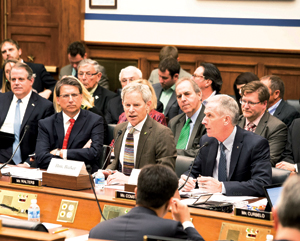State Leaders Pan Devolution, Press Congress for Highway Bill

This story appears in the March 23 print edition of Transport Topics.
WASHINGTON — A governor, a mayor and a state transportation director made the case before a House panel for federal transportation funding and against any notion that the states alone can maintain the nation’s infrastructure.
“Elimination of the federal program would be catastrophic to our state and many states . . . [and] to the country at large,” North Carolina Gov. Pat McCrory told the Transportation and Infrastructure Committee during a March 17 hearing.
The local funding sources that North Carolina has available today will cover only 18% of its transportation needs during the next decade, McCrory said, making the case against devolution, an idea popular with some conservative lawmakers who want to end federal transportation programs.
The committee’s ranking Democrat, Rep. Peter DeFazio of Oregon, said at the hearing that he wanted to “put a nail in the coffin, a stake through the heart, and garlic around the neck” of devolution.
The other witnesses were Salt Lake City Mayor Ralph Becker, who is president of the National League of Cities, and Wyoming Transportation Director John Cox, president of the American Association of State Highway and Transportation Officials.
Committee Chairman Bill Shuster (R-Pa.), who said he opposes devolution, asked the three what would happen if the federal government ended its funding and policymaking roles in transportation.
McCrory responded that devolution would destroy the concept of “connectivity” and, ultimately, would waste taxpayer dollars because highways likely would end at state borders.
“If we have a hodgepodge type of planning up and down the East Coast or going east and west . . . you’re going to have major segments of our transportation system in turmoil, which will impact the trade and commerce of the United States,” McCrory said.
Cox said a recent analysis showed that if the federal government ended its funding role in transportation, Wyoming “would have to raise our fuel tax 30-plus-cents a gallon in order to make up the difference.”
Becker, the Salt Lake City mayor, said the national economy is “completely dependent on having a good circulation system” and that a federal withdrawal would damage efforts to develop comprehensive transportation plans that integrate modes, such as port shipping and freight highways.
Becker also said that federal cutbacks in funding over the past decade and the lack of long-term transportation bills already have adversely affected the states’ ability to expand and maintain the transportation system.
“The great challenge we have today is we have an uncertain market, and we cannot plan and design the long-term projects,” Becker said.
The committee hearing dovetailed with the release last week of a letter to Congress decry-ing the concept of devolution and calling on lawmakers to pass a long-term transportation bill.
Among the nearly 40 signers of the letter were American Trucking Associations, the National Association of Manufacturers, the National Retail Federation, AASHTO and the League of Cities.
The witnesses and committee members stressed the need to pass a long-term transportation funding reauthorization bill.
Shuster said: “Because both sides of the aisle, both sides of the Capitol and both ends of Pennsylvania Avenue are talking about the need for a long-term transportation bill, I feel confident that we will get there.”
However, Congress last summer gave the current funding law, MAP-21, only a temporary extension, which runs out May 31. Neither the House nor Senate has proposed a new funding plan, and Congress will recess soon for Easter and Passover.
DeFazio has been calling on the Republican leadership to at least pass a temporary funding measure that would get states through the construction season without them having to cancel projects.
“Yes, we have a common objective on a six-year bill, but just to get to the end of this year with current anemic levels of spending would require $10 billion,” DeFazio said, adding that infrastructure deterioration reaches a point where it accelerates.
“Where suddenly what was a $1 million problem last year becomes a $5 million problem this year and becomes a bridge replacement problem next year,” he said. “So I feel a tremendous sense of urgency.”

